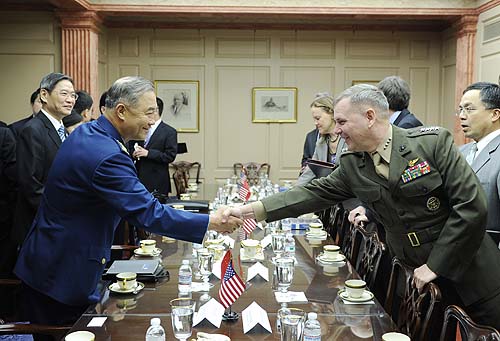|
 |
|
MILITARY EXCHANGES: Deputy Chief of the General Staff of the Chinese People's Liberation Army Ma Xiaotian shakes hands with Vice Chairman of the U.S. Joint Chiefs of Staff James Cartwright at the first Sino-U.S. Strategic Security Dialogue in Washington, D.C. on May 10 (ZHANG JUN) |
Despite disputes over trade, exchange rates and the investment climate, China and the United States are striving to promote cooperation through dialogue, as the two countries become increasingly dependent on each other and benefit substantially from each other's development, said Chinese officials and scholars.
The most recent effort was the two-day Sino-U.S. Strategic and Economic Dialogue (S&ED), which ended in Washington, D.C. on May 10. Chinese Vice Premier Wang Qishan and State Councilor Dai Bingguo co-chaired the dialogue with U.S. Secretary of State Hillary Clinton and Treasury Secretary Timothy Geithner, as special representatives of their presidents.
This was the third round of this two-track dialogue. It was upgraded from the former Strategic Dialogue and Strategic Economic Dialogue initiated by the two countries in 2005 and 2006 respectively.
"We had a good conversation, but we didn't agree on each and every issue," said Dai at the end of the talks. "But after each round of dialogue, we successfully expanded mutual understandings, increased trust and enhanced cooperation. This has added to our confidence of further developing our bilateral relations in the future."
Progress
The economic track of this year's S&ED "was successful and produced a large number of concrete outcomes," said Chinese Vice Finance Minister Zhu Guangyao. "It was a meeting of strategic discussions with a global vision."
The biggest achievement was the Sino-U.S. Comprehensive Framework for Promoting Strong, Sustainable and Balanced Growth and Economic Cooperation signed by Wang and Geithner, he said.
"The United States and China affirm both countries will, based on common interests, promote more extensive economic cooperation, from a strategic, long-term, and overarching perspective, to work together to build a comprehensive and mutually beneficial economic partnership, adding to the prosperity and welfare of the two countries, and to achieve strong, sustainable, and balanced growth of the world economy," the document said.
A major task of the third round of the S&ED was fulfilling the consensus reached by Chinese President Hu Jintao and U.S. President Barack Obama during Hu's visit to the United States this year, to move
Sino-U.S. relations toward a "cooperative partnership," said Tao Wenzhao, a senior research fellow with the Institute of American Studies at the Chinese Academy of Social Sciences.
In January, Hu paid a state visit to the United States, during which he and Obama reached a consensus on building a cooperative partnership based on mutual respect and benefit. The visit charted a clear course for the future of Sino-U.S. relations.
The framework signed during the S&ED would build on the momentum to step up bilateral cooperation, Tao said.
During the dialogue, the two sides discussed a wide range of topics, including long-term issues in bilateral economic cooperation, Europe's sovereign debt crisis, the nuclear disaster triggered by Japan's earthquake, as well as the turbulence in the Middle East, and its significance for the global economy.
A highlight of the strategic track of the third round of the S&ED was the establishment of the Sino-U.S. Strategic Security Dialogue (SSD).
"To build a solid partnership between the two countries, it is important to strengthen the weak areas of their bilateral relations, including the military relationship," Tao said.
Chinese Vice Foreign Minister Zhang Zhijun and Deputy Chief of the General Staff of the Chinese People's Liberation Army Ma Xiaotian attended the SSD, along with U.S. Deputy Secretary of State James Steinberg and Under Secretary of Defense Michèle Flournoy.
The SSD was established to help boost Sino-U.S. military exchanges, which have always lagged behind economic and strategic discussions. The move was significant, because it was conducive to enhancing mutual trust, eliminating suspicions, strengthening understanding and expanding areas of cooperation, Tao said.
| 